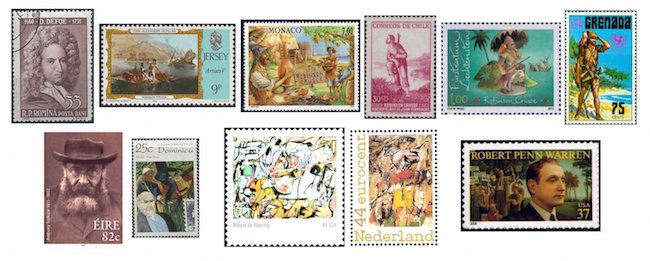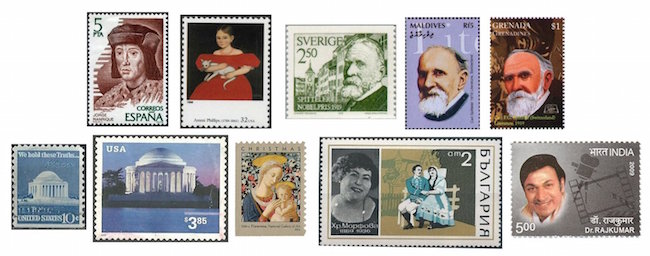The Arts on the Stamps of the World — April 24
An Arts Fuse regular feature: the arts on stamps of the world.

By Doug Briscoe
Our four top arts figures on stamps for today are Daniel Defoe, Anthony Trollope, Willem de Kooning, and Robert Penn Warren. Then there are six more, a 15th-century Castilian poet, a 19th-century New England portraitist, a Nobel Prize-winning Swiss poet, the designer of the Jefferson Memorial, one of the best-loved Indian actors in the Kannada Cinema, and a Faroese architect who also designed postage stamps.
We commemorate Daniel Defoe today because he died on this date in 1731. His birth date and even birth year (it must have been around 1660) are unknown. Defoe’s birth name was Foe. He added the prefix “de” later so as to pretend to be of aristocratic lineage. He started in business and did very well indeed, buying a country estate and a ship! There is reason to believe that he was not always entirely scrupulous in his dealings, and he was often in debt. Despite a rather late start in literature he produced a large body of work, not just Robinson Crusoe, Moll Flanders, and A Journal of the Plague Year, but hundreds of other articles and books. A few Defoe trivia: his house was one of only three in his neighborhood that survived the Great Fire of 1666; he was pillaried for one of his political pamphlets; over the course of his writing career he used about 200 different pen names. We have only one portrait stamp (from Romania!), but several from around the world for Robinson Crusoe.
The ever-likeable Anthony Trollope (24 April 1815 – 6 December 1882) wrote 47 novels, the favorites being two six-book series, the Palliser political novels and the Barsetshire set, of which the first two, The Warden, and Barchester Towers, particularly shine for me. Those two alone were made into a wonderful BBC miniseries called The Barchester Chronicles in 1982. Trollope worked for ten years in Ireland in the postal service (much of his writing was done on trains while traveling on postal business), so it is entirely appropriate that he should be honored on a recent Irish stamp. One of his more extensive business trips was to British possessions in the Caribbean, one of which, Dominica, signaled his visit with a stamp of its own. He thought the island very beautiful and wrote a book about the region, The West Indies and the Spanish Main, in 1859.

I was surprised to find only two stamps for Dutch-American abstract expressionist Willem de Kooning (April 24, 1904 – March 19, 1997): Asheville (1948) and Woman and Bicycle (1952). Born in Rotterdam, de Kooning stowed away on board ship and debarked in Newport News, Virginia (an illegal immigrant!), making his way by way of Boston and Hoboken to New York. In Manhattan he met his mentor Arshile Gorky. By 1937 was he was earning his living as an artist. De Kooning became a citizen in 1961 and took up residence on Long Island, where he began working in sculpture and lived for the rest of his life.
Robert Penn Warren (April 24, 1905 – September 15, 1989) is the only person to have won the Pulitzer Prize in both fiction and poetry. He earned his first one for the novel All the King’s Men in 1947 and two more for poetry 1958 and 1979. He was born in Kentucky, went to high school in Tennessee, and pursued his education at UC Berkeley and Yale. He was a Rhodes Scholar at New College, Oxford. It was while teaching at Louisiana State University that he had the opportunity to observe the political shenanigans of Huey Long, the model for Willie Stark in All the King’s Men. (Carlisle Floyd wrote an opera to his own libretto called Willie Stark, first performed in 1981). Probably Warren’s second best known book is Who Speaks for the Negro?, a 1965 collection of interviews with civil rights activists.
As with Defoe, we don’t know when Jorge Manrique was born (c1440), but he was killed while trying to take the castle of Garcimuñoz on (according to most sources) 24 April 1479. He was a partisan of Queen Isabel I of Castile against her half-brother Henry IV, and the castle was held by one of Henry’s staunch supporters. Manrique’s poetical masterpiece was the Coplas a la muerte de su padre (Verses on the death of [Don Rodrigo Manrique,] his Father), much admired by Lope de Vega. Manrique also composed love lyrics.

At the age of 21, early American artist Ammi (AM-eye) Phillips (April 24, 1788 – July 11, 1865; not to be confused with Emo Philips) was placing advertisements offering his services as a portrait painter. Possibly self-taught, Phillips was born in Connecticut and had to become itinerant in Massachusetts and New York in order to earn a living. The stamp shows the upper two-thirds of his best known work, Girl in Red Dress with Cat and Dog (1830-35) (the dog is in the bottom third).
Swiss poet Carl Spitteler (24 April 1845 – 29 December 1924) won the 1919 Nobel Prize for Literature “in special appreciation” of his magnum opus, the epic poem Olympian Spring (1900-05). Spitteler was born in the far north of Switzerland, southeast of Basel. As a boy he had Jacob Burckhardt as one of his schoolteachers. He studied law and theology Zurich, Heidelberg, and Basel, but gave up his vocation for poetry. A work he composed in 1881, the allegoric prose poem Prometheus and Epimetheus, was much later given extensive treatment by Carl Jung in his 1921 study Psychological Types. I can’t help wondering whether Spitteler’s reworking and retitling of the poem (as Prometheus the Sufferer, 1924) was in any way prompted by Jung’s analysis.
American architect John Russell Pope (April 24, 1874 – August 27, 1937) has many buildings to his individual credit, but his most recognizable work was finished after his death by his firm. I’m thinking of the National Gallery of Art (1938-41) and the Jefferson Memorial (1939-42), both in Washington, D.C. Pope also oversaw the creation of National Archives Building (1933-35) and the Duveen (or Elgin) Gallery of the British Museum, which was designed to house the Elgin Marbles. I seize the opportunity to add a stamp of a painting from the National Gallery that was chosen for last season’s US Christmas Madonna stamp. It’s an anonymous fifteenth-century Florentine piece we might not otherwise have a chance to see in these pages.
Bulgarian soprano Christina Morfova was born on this day in 1889. She made her debut in Brno in 1910 and was the first woman to produce an opera in Bulgaria (Smetana’s Bartered Bride). Although she performed throughout Europe—London, Paris, Berlin, Moscow, and elsewhere—and sang prominent and varied rôles including Violetta, Tosca, Mimí, the Queen of Night, Donna Anna, and Santuzza, today she is little known outside her native Bulgaria. (Her Wikipedia article, for example, is limited exclusively to the Bulgarian language page; I find no recordings on Amazon and no sound files on YouTube. Apparently there is a women’s choir named for her.) She was killed in a car accident in 1936.

The revered Indian actor and singer known both by his screen name, Rajkumar (or Dr. Raj Kumar), and nickname, Annavru, as well as a host of endearing honorifics (Golden Man, Jewel of Karnataka State, Emperor of Actors, Singer in the Court of Gods, and on and on), was born Singanalluru Puttaswamayya Muthuraju (24 April 1929 – 12 April 2006) in Tamil Nadu in the far south of the subcontinent. He quit school to take up acting and trod the boards for a quarter century before landing a role in a film, Bedara Kannappa (1954). He went on to make 200 more. A man of self-discipline, he refused to appear onscreen smoking, drinking, or using profanity. He was once kidnapped for ransom and held for 108 days.
Today’s only subject who is still living is the most important architect of the Faroe Islands, Jákup Pauli Gregoriussen (born April 24, 1932). He was educated at the architectural school of the Royal Danish Academy of Art in Copenhagen. Two of his buildings are seen on Faroese stamps: the Faroese National Library (1979) and the Listasavn Føroya (National Art Museum, completed 1993). It is hardly surprising that his stamp designs have mostly been of old houses and views of towns and villages. I show a generous sampling of these. Gregoriussen is also the author of a richly illustrated four-volume study of Faroese churches, which earned him the Faroese Literature Prize in 1998, and an advisor on the restoration of those churches.
A graduate of the University of Massachusetts with a B.A. in English, Doug Briscoe worked in Boston classical music radio, at WCRB, WGBH, and WBUR, for about 25 years, beginning in 1977. He has the curious distinction of having succeeded Robert J. Lurtsema twice, first as host of WGBH’s weekday morning classical music program in 1993, then as host of the weekend program when Robert J.’s health failed in 2000. Doug also wrote liner notes for several of the late Gunther Schuller’s GM Recordings releases as well as program notes for the Boston Classical Orchestra. For the past few years he’s been posting a Facebook “blog” of classical music on stamps of the world, which has now been expanded to encompass all the arts for The Arts Fuse.

Fabulous day of stamps and gems of info, as usual. Thanks!
Fascinating!! If I ever teach a Humanities course as I helped do for six years at Marian University, I’d share this with my students… Thank you, Doug Brisco!!